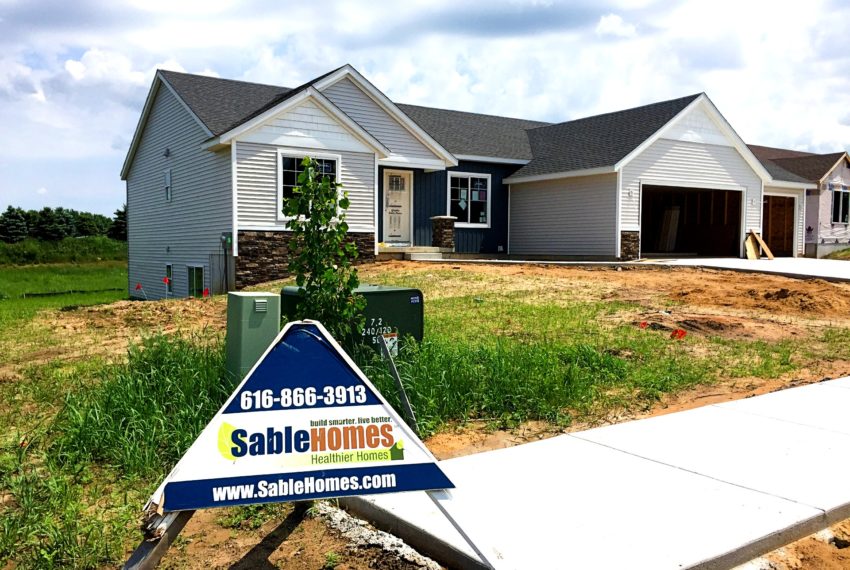
John Bitely to GRBJ: Attainable housing in West Michigan continues to shrink, largely due to government regulation
For years, Sable Homes President John Bitely has been working tirelessly with local chambers of commerce, economic organizations like The Right Place, and municipalities in an effort to provide an ample supply of workforce housing in West Michigan.
In a recent interview with the Grand Rapids Business Journal, Bitely said this obstacle will only continue to grow as local governments are deciding they want bigger and “nicer” homes in their communities rather than the traditional starter home — essentially a 1,400-square-foot home priced below $200,000 that helps a buyer build equity and net worth.
“It’s going to become a bigger and bigger issue,” Bitely said in his interview with GRBJ. “It’s very interesting, because everyone recognizes it as a major issue, but society’s unwillingness to do anything about it continues to amaze me.”
It’s no secret West Michigan is experiencing a housing crunch that largely stems from a dearth of starter homes, GRBJ reported. While there is a shortage of housing nationwide, the most vital category, the starter home, is quickly shrinking.
“We give it lip service, but when it comes time to do things that would help with it, we see a vast majority of people, including townships and municipalities, do things that make it worse,” Bitely said.
Zoning issues
Bitely said while material and labor costs are a major part of the rising costs of new builds, it is zoning that makes the most difference.
“We continue to see townships requiring larger lots, more acreage, more square footage and continued escalation of requirements for building neighborhoods,” he told GRBJ. “Some is cost of material and labor, and those are big numbers, but the hidden part is the regulation. Once those are on the books, we can’t get rid of it. And when we go to develop a neighborhood and say ‘affordable,’ we’re booed and hissed at as developers because neighbors think we’re talking subsidies.”
Bitely said what he means when he says affordable is attainable housing for those making between $85,000 and $125,000 annually. Young prospective homebuyers often are hard-pressed to afford more than a traditional starter home.
Meanwhile, Bitely has heard certain community leaders flat out say they do not want homes priced below $500,000.
“They all want to be a Cascade or Ada, all extremely nice McMansions and high-income individuals,” he said. “But what they fail to realize was the way those communities started and that was with affordable, workforce housing.
“Nobody is saying we’ll take working Americans today because we know 10 years from now, half or more will need or want a nicer home. Instead, they’re sending (buyers) away not realizing they won’t come back.”
Bitely also pointed to existing neighborhoods with starter-home-style structures from the mid-1900s, like Westgate in Grand Rapids. The 1,000-square-foot ranches were built largely without finished basements and no garage. They could be added onto as families needed and could afford.
Buyers still happily line up to buy them. If Bitely were to build similarly now?
“If I build with those amenities now, we would be scorned as building blight,” he said.
Home prices going up
In 2011, the median home in the Grand Rapids-Wyoming metro area was $99,500, according to real estate analysis firm Point2, GRBJ reported.
In 2022, median home price is $299,500. That would require a median income of $83,558 at the current 6.25% interest rate to purchase the home. The average salary in Grand Rapids? According to Payscale, it is $64,000. Along with the regulations, builders are quick to construct larger homes even if smaller is an option, since that’s where they make money.
“I’m one of the few who will (build smaller), because I came from working class America,” Bitely said. “If we make 5% profit on a home and you build a $500,000 versus a $100,000 home, that’s five to one. It’s five permits, five lots, five projects to follow through. It’s not a great business model and our society has blocked that option.”
Rising rates don’t help
In 2019, the $220,000 median home in the United States would require a $49,000 household income. That same home has increased in value 48% in 2022, to $325,000.
Mortgage rates, meanwhile, are more than double that of three years ago, meaning buyers would need more than $90,000 to purchase the same house.
More than 8% of homes in the United States are now worth more than $1 million, according to Redfin.
The share of small homes is shrinking too, as in 1940, nearly 70% of new homes were 1,400 square feet or less. Today, that market share is less than 8%, according to CoreLogic.
Investors, rentals swoop in
In the first quarter of 2022, Redfin found nearly 20% of homes were bought by investors, according to GRBJ. Global financial institutions are investing in homes and turning homes into rentals because of growing profitability in rental markets.
“There are reasons people are buying them up and putting them in investment portfolios, especially with projections that rents will continue to go higher,” Bitely said.
Many of those investors either razed the homes to make way for larger, more modern versions or pushed them into the rental market.
The younger generations that historically would be looking at starter homes are more apt to rent than ever before. Whether that’s by choice or not, is another question. Some of those renters, however, can save up and skip past the starter home stage, Bitely said.
“The reason we haven’t seen some of the outcry is the younger generation is OK with spending early years in adulthood renting,” he said.
Policy changes
Bitely said across the country, community members need to stand up to their local governments in support of providing attainable housing options. Some states have started working on zoning laws to help increase housing density, which will vary market by market.
Read the full GRBJ story, here.
